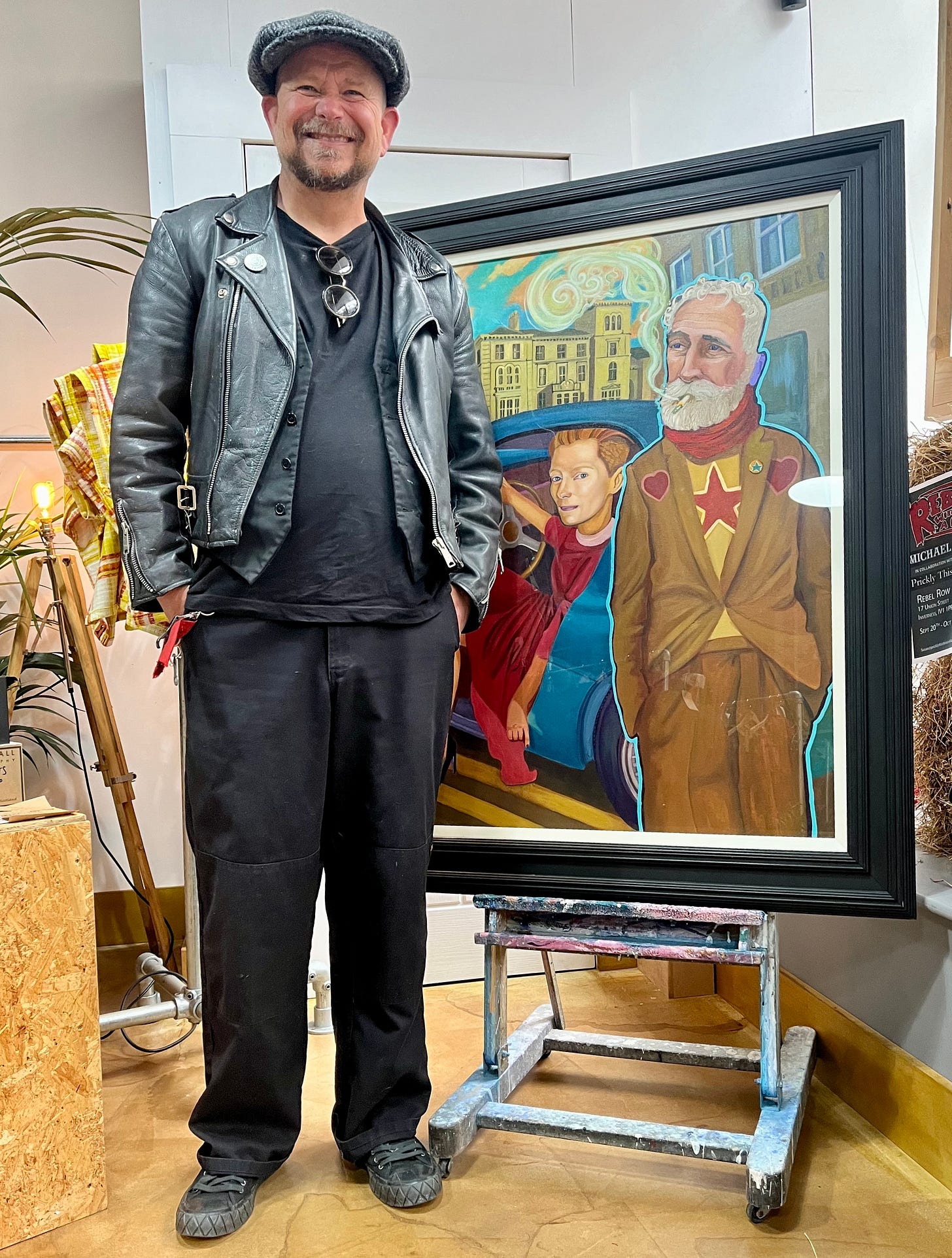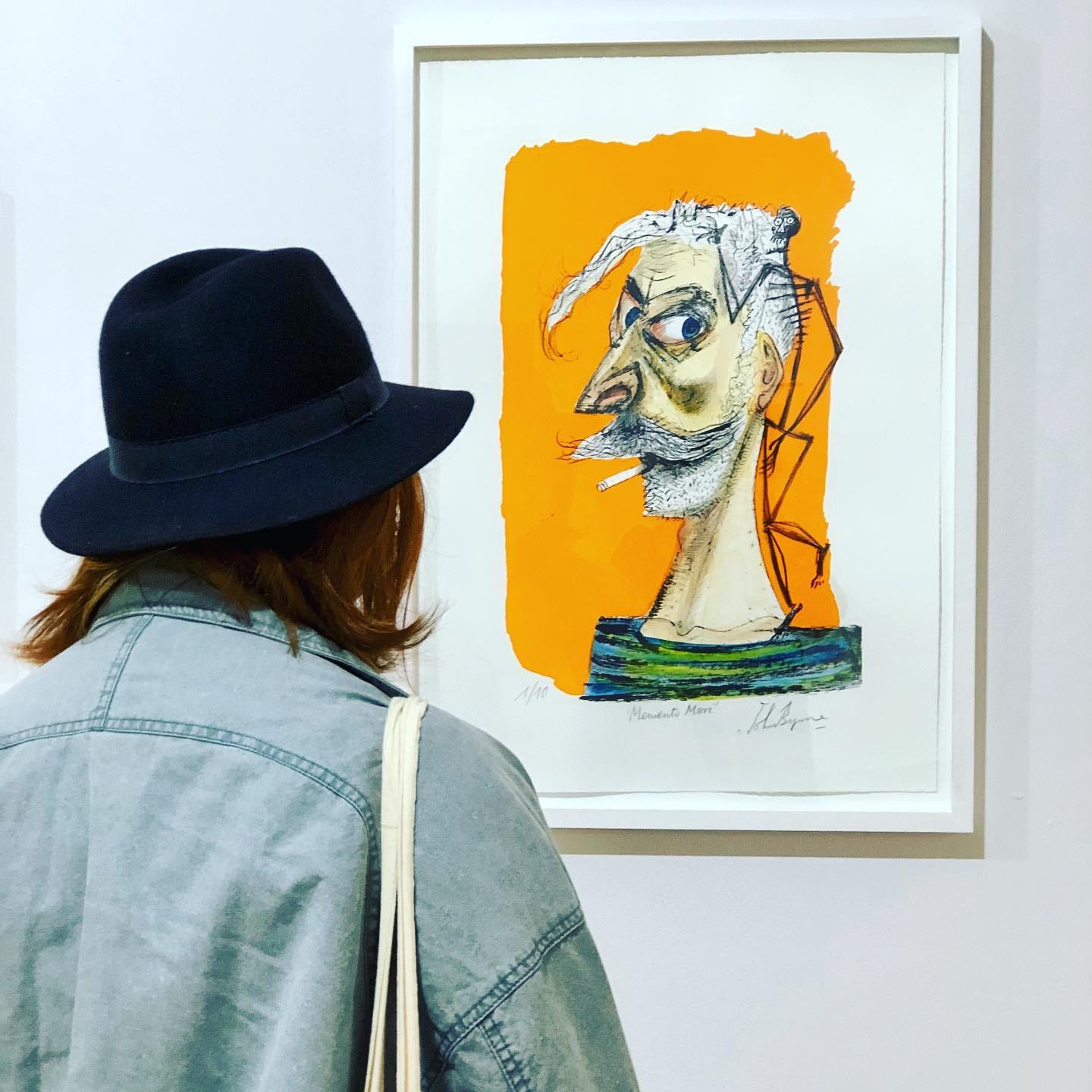
"What would John Byrne do? It's something I think about often…" self-styled Highland pop surrealist Michael Forbes tells me, as we stand in front of his painting of the late great artist and writer, John Byrne and his former partner Tilda Swinton.
Me too.
I remember interviewing John years ago for The Herald and he told me he didn't write, he rewrote. Just like Broadway writer, Moss Hart. I often think of John as I toil away at the coalface of verbiage.
What would John Byrne do with this limpid prose? No question… he'd rewrite it.
What would John Byrne do when he didn't have a deadline? He'd shake his head, light a fag and do the work. Always.
What would John Byrne do with his M.B.E. for services to literature and theatre? He'd return it in protest against the war in Iraq.
Mike's painting of John and Tilda Swinton (despite her fame, reduced to a bit part), was made a few weeks after the much-missed artist and writer died late last year. It’s currently perched on an easel at Rebel Row in Union Street, Inverness.
It depicts the moment Mike bumped into the couple on the very street we are on now in Inverness.
Mike has an exhibition in the store, Rebels With A Cause, which – in homage to the spirit of Rebel Row and its mother brand, Prickly Thistle – presents off-kilter Highland scenes featuring bold women like Debbie Harry and Greta Thunberg.
He tells me that once, years ago – perhaps even last century – he spotted John Byrne on Union Street smoking a cigarette. He was vaguely aware of Tilda Swinton in the car, but he had eyes only for JB, his artistic hero. Looking cool. As per.
After taking a turn around the block to compose himself, Mike went up to John and introduced himself. "He was incredibly friendly and kind,” he says. “I waffled some nonsense. I was in the company of one of my heroes and was overwhelmed. Yes, I was aware of Tilda sitting in the car, but in that moment I was enjoying the company of Scotland’s greatest artist."
Like John Byrne, Mike is a born storyteller. The painting, which shows John in typically dapper form surrounded by a blue aura, has an elegiac 'remembrance of times past' feel. "It is that moment as I remember it," Mike says.
I think he should do more paintings like this one. Recently, he has been exploring the Highland Clearances in his work and I really like this direction. One of these paintings, 240 Burning Houses, has been shortlisted for the this year’s Highland Art Prize.
Artists like John and Mike play an important role in society; creating narratives around our lives, our popular culture and our shared history. They reflect us back to ourselves. Often with a surreal edge, which I always like.
Take John’s six-part tragi-comic drama Tutti Frutti, first broadcast on the BBC in 1987 (and available in the UK by clicking on the link). It was sheer genius. John’s hand was all over it, from the script, to the visuals, to the kitchen sink in Mr Clockarty’s office where Miss Toner grudgingly made the tea.

On the day John’s death was announced in December last year, I was honoured to be invited to do a live chat on BBC Scotland's Afternoon Show with presenter Nicola Meighan and fellow arts journalist and Noise of Art Substacker, Neil Cooper.
Actor Gavin Mitchell, also contributed with some beautiful memories of his old friend, which formed the basis of a eulogy he later gave at John's funeral. 'He painted with words,” said Gavin.
You can listen to it HERE.
In the couple of hours I had to prepare for the radio show, I wrote the following notes of John’s well-lived creative life. They’re a wee bit staccato, since I wrote them to have in front of me as an aide memoire. But worth sharing, I think.
John Byrne’s life was art…
JOHN BYRNE was fascinated by the oddity he found in humankind and injected it into all his work, be that visual or the written word. In the most magical and often surreal way. Everything came from wellspring of his own life and times.
He was a true original. A true creative. He always went against the grain, from the very outset of his career as an artist. Born in Paisley in 1940, at the age of 18, after a spell as a Slab Boy with Paisley carpet manufacturers, AF Stoddard & Co, mixing colours for carpet designers, John got into to Glasgow School of Art (GSA). He felt he didn’t fit in, so he transferred to Edinburgh College of Art.
That didn’t work for John either, so he returned to GSA. His interest in portraying figures was then at odds with the prevailing fashion. It was a fascination which lasted a lifetime.
One lecturer at GSA said he was ‘unquestionably one of the most able painters we have seen in the past 20 years’ and he won the Newbery medal for best final year student.
Writing was always a part of John's life. While still at art college, he wrote to art student pals as fictional character, Francis Seneca McDade from Shoogley Peg. John would go on to revive McDade in his 1977 play Writer's Cramp. The play – his first – tells the life story of an aspiring writer and would-be artist from Paisley.
During the 1960s, by then married with two young children, spells followed working as a graphic designer for STV, Penguin books, and as a carpet designer back at Stoddard’s. John also taught night classes at GSA.
His breakthrough as an artist came when he read a piece in The Observer magazine in 1966 about naive, ‘primitive’ painters, who held down day jobs but painted at night for pleasure. Ever the storyteller, he created a character, Patrick based on his father; a news-seller. His alter ego was picked up by Portal Gallery in London who offered him a solo show. John fessed up before the opening…
John continued to sign his name Patrick until the end of his life.
Many phases followed, including:
Murals on Glasgow gable ends
Americana, heavily influenced by music scene of his youth and subsequent visits
Album covers; for pal Gerry Rafferty, The Beatles, Donovan
Self-portraits (always) and portraits of pals such as Billy Connolly. He also painted on instruments
Set design, starting out with likes of Billy Connolly’s Great Northern Welly Boot Show (NB Billy Connolly's painted suit for an appearance on Parkinson)
Writing from 1976 for theatre; Slab Boys Trilogy, Writer’s Cramp, Colquhoun & MacBryde, Underwood Lane. Later, Tutti Frutti and Your Cheatin’ Heart for BBC.
Illustrated kids book Donald & Benoit, based on a story he told his twins, Honor & Xavier with Tilda Swinton. Donald and Benoit was adapted and dramatised in 2021 by his wife Jeanine.
John was honoured with retrospective, John Byrne: A Big Adventure – Artist, Writer and Theatre Maker, at Kelvingrove Art Gallery in Glasgow in 2022. (Read my story on this in The Sunday Post.)
At the time, I was invited onto BBC Radio 4’s Front Row to talk about the retrospective - and John. In hindsight, it was as though I was explaining an alien to an English audience. John was a household name in Scotland, but despite his immense versatility and talent, not so much south of the border.
(I’ve just checked and the Front Row in question, from 15 June 2022 is still available to listen to…)
I remember reading a profile of Tilda Swinton in The Observer and it was as if the writer had no idea of the cultural significance of John Byrne. Perhaps that was down to John not being a showman for himself – although he was without a doubt the most stylish man in Scotland… a show-not-tell-man. (In the broadcast, by the way, I muddled this up and said he was a show-and-tell-man. Cue facepalm emoji.)
As the big Kelvingrove retrospective illustrated, in his visual art, John Byrne was an art alchemist. He could magic up any style or subject matter. He was a one-off. Dressed as if he was a character in a play of his own making; handlebar moustache, twinkle in the eye, fag in mouth, tweeds, long coats and gorgeous scarves, there was no-one like him.
As former arts editor at The Herald, Keith Bruce, once said to me, it was hard to take a bad picture of John. His self-portraits were plentiful and drawn/painted until his death. If I looked like John, I’d be drawing myself all the time too.
Always curious, courteous, warm-hearted and generous, he was The Real Deal, but he’d have laughed that description off, I'm sure.
After he died, I read lots of comments on social media along the lines of: 'never meet your heroes’, but in the case of John Byrne, that didn’t apply.
That is pretty much his epitaph.






Such a warm and insightful piece. Thank you.
Thank you. I don’t know nearly enough about him and came to him via Tilda. I feel like I know more now and will explore.